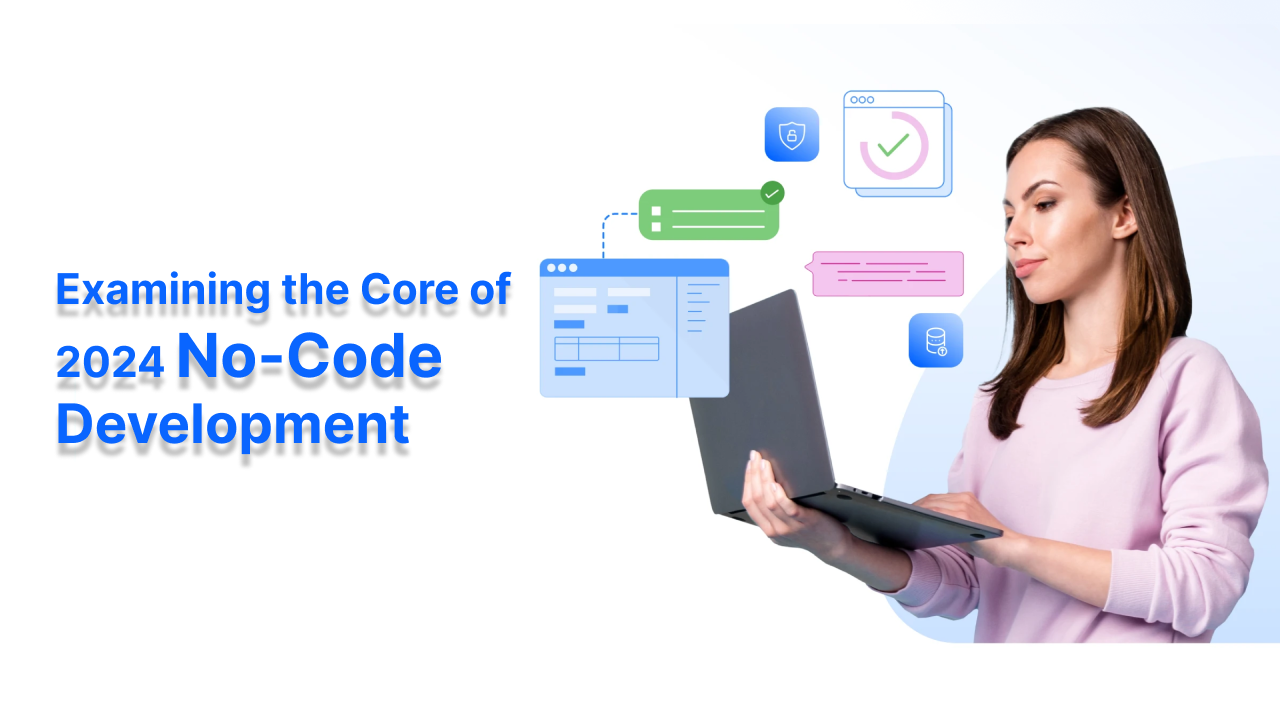The need for software solutions has grown significantly in the fast-paced world of today, surpassing the time-consuming nature that is conventional coding. Now introduce no-code, a force that alters the circumstances. What precisely is no-code, though? This article covers its history, options, and practical applications, which range from modifying apps to improving processes. We’ll look at its pros and cons as well as how significant a role it will play in altering the course of software development.
No-code development is a simplified approach that improves software creation by doing deal with the requirement for a lot of coding. Applications includes field operations optimization, tracking of inventory, knowledge databases, CRM systems, automation of workflows, HR management, field activities optimizing, rapid development with MVPs, and more. This article analyzes its beginnings, discusses discusses verb Third-person singular simple present indicative form of discuss Report Word the differences between low-code and zero-code gets closer and predicts its projected expansion in the application development arena.
Exploring the No-Code Evolution’s Origins
It is important to explore No-Code’s history in order to comprehend its present Report Phrase and future. In the past, only really skilled programmers and developers could create applications through carefully creating lines of code. While successful, this method was often costly and laborious, and needed a thorough understanding of coding concepts and languages used for programming. In response to these challenges, the No-Code movement was born, aiming to make developing software accessible to a broader spectrum of users and democratize the process. Several factors caused the development of no-code:
Several significant developments are the origins of the No-Code movement:
The early 2000s saw the rise of artistic tools. With the advent of visual development tools, consumers could now build programs without understanding any code. These tools used dragging and dropping interfaces that enabled users to construct interfaces and processes visually, eliminating the requirement for manual coding.
WYSIWYG Directors: In the world of web development, the concepts of “no-code” and “WYSIWYG” (What You See Is What You Get) edit have become prominent. Through the use of visual tools for design rather than complicated programming, these techniques made the procedure of creating sites simpler for customers.
The low-code trend gained traction in the 2010s, preceding the No-Code movement in this regard. Because platforms with little code don’t require as much coding and still offer customization opportunities, they expedite the procedure of creating apps. The divide among codeless development and conventional coding began to close with this trend.
Demand for Fast Solutions: Businesses require quick solutions more and more to adapt to the changing needs of the market in today’s rapidly evolving digital landscape. This is where traditional development cycles frequently fall short, which fuels the need for more rapid easier-to-use development techniques.
Together, these elements established the foundation for the No-Code motion, which is a reflection of a larger movement to open up the creation of software and enable a larger range of people to engage in the creation and creation of digital solutions.
The no-code approach
Offering an alternative to traditional software development gets closer, the No-Code approach allows developers to develop useful and scalable applications. It is true that it increases access, but it is not entirely non-technical or easy to understand. Instead, it entails a complex and intentional process that calls for an extensive knowledge of pertinent technology in along with excellent problem-solving abilities.
No-Code redefines the use of professional competence rather than doing away with it. A variety of skills are needed on the part of No-Code developers, including:
Problem-solving: No-code developers have to be skilled at recognizing company challenges and come up with no-coding tool solutions. This includes creating workflows, linking various software parts efficiently, and implementing workflow automation.
Platform expertise: It’s essential to grasp the special features and tools offered by each no-code platform. Such platforms require skilled management by developers in order to fully utilize their potential while comprehending their constraints.
Data management: Programming without programming needs an excellent grasp of data handling. In order to develop data-driven applications, programmers must possess excellent data the company, abuse, and analysis abilities.
Integration abilities: Linking various software services and systems is typically necessary whereas utilizing no-code. It is essential that programmers show expertise in integrating APIs from third parties and ensuring uninterrupted interaction throughout different components.
Optimization and scalability: careful preparation and optimization are crucial when creating no-code apps that are prepared for company growth. It is the responsibility of programmers to make sure that their goods can handle increasing user numbers and evolving requirements.
No-code tools
No-code platforms, occasionally referred to as no-code tools, allow the development of applications that work without needing a lot of traditional programming expertise. Rather, each platform offers a distinctive environment in which users can define the behaviors and features of their apps through a graphical user interface.
These platforms take on numerous kinds and serve various purposes.
No-code for app building
No-code apps that are dedicated through app development give customers the capacity to design and create an extensive variety of computer applications, from simple utilities to intricate, based on data systems.
Consider Bubble.io as a case study. It offers an interface that is both visual and has a strong backend, allowing users to develop online applications that include databases, authentication for users, and fluid workflows. Bubble.io can be helpful for creating apps like social networks, marketplaces, project management software, and more.
No-code for website creation
Bubble.io developers are experts in application development, which enables them to create and develop an extensive variety of software uses, from simple utility to intricate, based on data platforms.
Bubble.io offers developers the capacity to create web-based applications with databases, authentication for users, and fluid workflows due to its beautiful interface and robust back architecture. It is particularly suitable for creating applications like social media platforms, markets, project management software, and more.
Micro-process no-code tools
Some no-code methods focus on streamlining and streamlining workflows and tasks, allowing users to develop automated processes that save cost of labor and saving time.
Many no-code structures, such as those listed previously, have automated functions. Consider Glide, Zapier, and Bubble as instances of excellent apps that let users automate processes and duties. These systems make it simpler to create unique processes that increase output while freeing away essential assets. No-code automation tools offer the ability to effortlessly handle data, manage communication, and enhance user experiences.
How no-code works
Visual modeling: With drag-and-drop activities, users can develop the framework and layout of their apps using visual modeling, considered the initial stage in no-code platforms. Every element which is placed on a canvas, including buttons, shapes, or tables of data, represents a particular part or feature of the application itself.
Metadata generation: At the same time, when users build their apps aesthetically, the no-code platform generates data. This metadata acts as an essential foundation for the workings of the application by describing the features, interactions, and actions performed by every part.
Code generation: Code generation techniques are used by no-code platforms after visual layout and metadata growth. These methods translate metadata into code for the backend automatically. The logic they include comprises automation of processes, data storage, and interaction with users control.
Data management: Database management solutions are frequently incorporated with no-code platforms for data management reasons. The platform generates the necessary code to create and handle database when customers specify data structures or set up data tables in their applications, guaranteeing seamless information abuse, retrieval, and storing.
Event handling: Moreover, organizing events is efficiently handled by no-code structures. Events within the app are set up by actions taken by users like pressing buttons and form submissions. The actions to take when reacting to these signals are specified by the code supplied by the platform itself. For instance, when a user hits “Submit,” the data storage and processing is determined by the code supplied by the platform.
Integration connectors: Furthermore, integration connectors with pre-built APIs and connections to external systems and services are offered by no-code platforms. The platform-generated code makes it simpler for consumers to integrate their mobile applications with additional offerings like email service providers or payment processors, as these connections simplify the setup process.
Automation engine: An augmentation engine handles automated processes on no-code platforms. For automated handles like emailing out communications or changing records, users can set up conditions and rules. These computerized procedures are guided by the code given by the system, which guarantees the directions are followed properly.
Hosting and deployment: Generally, generated apps are stored and delivered by no-code platforms. They offer the required servers to host the application on the web or handheld devices, ensuring accessibility for users. This involves upgrades, scalability for facilitating app growth, including server security management.
Runtime environment: The no-code platform offers a runtime context in which the created code runs. The code is read and executed by this setting, enabling the intended features of the application to operate.
Difference between no-code, low-code, and zero-code
Understanding the distinctions between these three development approaches is pivotal.
No- code: No- law platforms enable addicts to beget applications with minimal or no traditional coding. Users leverage visual interfaces, mechanizations, andpre-built elements to design applications. While the focus is on a code-free experience, some no- law tools permit addicts to incorporate limited customizations through code if necessary.
Low- code: Low- constitution platforms streamline employment development while offering higher elasticity for custom coding. addicts can apply low- echelon coding to further customize their exercises or incorporate complex features.
Zero- code: Zero Code takes automation to the extreme by emphasizing complete automation, allowing users to create applications without any manual coding or configuration. It often relies on artificial intelligence andpre-built templates for rapid app creation.
Pros of no- law development include
Speed: No- law tools accelerate application development, allowing companies to promptly react to market changes and client demands.
Cost- effectiveness: With reduced elaboration time and resources needed, no- law approaches can be more charge-effective analogized to classical coding approaches.
User- centric: No- law devices prioritize user expertise, facilitating the innovation of applications that better align with user demands and preferences.
Rapid prototyping and iterations: Users can swiftly case and essay classics, assisting in the advance of conceptions before accomplishing to full- scale development.
Cons of no- law development include
Limited customization: No- law platforms may have checks when it comes to implementing highly specialized or unique functionalities, confining the bound of customization feasible.
Scalability challenges: Some no- law applications may chance scalability aftereffects as they develop, claiming again developed results to hold growth.
Seller cinch- in: druggies may grow dependent on concrete features of a individual no- law platform, potentially sophisticating the transition to elective evolution fashions if challenged.
Complex systems: Extremely complex applications may still demand habit coding, ceding no- law less capable for given use cases challenging a high grade of complicacy.
The Future of no-code
A fresh approach in the creation of software is being molded by the arrival of no-law technology. In late 2021, Forbes highlighted the disruptive impact of low-law and no-law tools, emphasizing the substantial investment in startups collected by Webflow and Bubble.
undoubtedly, this groundbreaking shift has taken place, with platforms that do not require code being the mainstay in the creation of software. By 2025, 70 percent of new apps will be built on low-code or no-law platforms, estimates Gartner.
The future of no- law technologies is conditioning a new paradigm in software development. Forbes highlighted the disruptive influence of no- law and low- law tools in late 2021, underscored by substantial seed funding secured by platforms like Webflow and Bubble.
This transformative shift is undeniable; No- code platforms are emerging as a dominant force in software development. According to Gartner, by 2025, 70 of new applications will be crafted using low- code or no- law platforms.
In the years to come, organizations of all sizes and individual innovators will increasingly work these platforms to manifest their creative visions. This heralds an era where the spotlight shifts from coding intricacies to the van of creativity, problem- solving, and innovation. Businesses will adapt and innovate more swiftly, unencumbered by the constraints of sluggish, traditional coding methods.
Looking ahead, it’s clear that no- law platforms will remain to develop and better in grade and credentials, with their adoption proliferating as further individualities and businesses embrace them.
Embrace the future with no- law! Connect with us moment for expert discussion and a bespoke quotation acclimatized to your needs.















